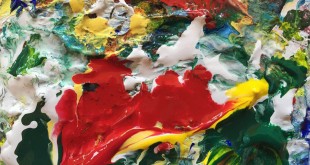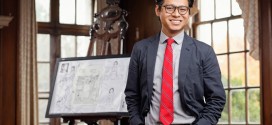By Amanda L. Andrei

 To enter the world of abstract expressionism is to jump into a jungle of fierce colors, explosive textures, and unruly patterns. This month, the Phillips Collection opens its doors to the wild world of Angels, Demons, Savages: Pollock, Ossorio, Dubuffet, an exhibit focusing on the artistic influences and close friendships between American painter Jackson Pollock (1912-1956), Filipino American artist and patron Alfonso Ossorio (1916-1990), and French painter Jean Dubuffet (1901-1985).
To enter the world of abstract expressionism is to jump into a jungle of fierce colors, explosive textures, and unruly patterns. This month, the Phillips Collection opens its doors to the wild world of Angels, Demons, Savages: Pollock, Ossorio, Dubuffet, an exhibit focusing on the artistic influences and close friendships between American painter Jackson Pollock (1912-1956), Filipino American artist and patron Alfonso Ossorio (1916-1990), and French painter Jean Dubuffet (1901-1985).
Pollock’s drip paintings are well-known for their chaotic and pure expression of form and color. And Dubuffet is famous for his style of art brut (“raw art”), the art of social outcasts and outsiders. Yet Ossorio is rarely mentioned, despite being a full-time painter, a significant patron of the arts, and a close friend of both Pollock and Dubuffet. The exhibit pays tribute to Ossorio, who despite being overshadowed in art history was highly influential in the abstract expressionism movement.
Born in Manila on August 2, 1916 to a Spanish father and a Chinese-Filipino mother, the young Alfonso Ossorio left the Philippines at age eight and attended private schools in England and the United States, graduating from Harvard in 1938. The following year, he became an American citizen. By the age of 25, he was already having gallery shows in New York, where he eventually met and befriended Jackson Pollock. And in 1950, on a commission to paint murals for a local church, he returned to Occidental Negros, the island where his father had started the first sugar refinery in central Philippines.
The murals, called “The Angry Christ,” initially inspired controversy, but were eventually accepted and even adored by the community. In a little known aspect of art history, Pollock used Ossorio’s studio while he was away. It was in this period he shifted away from his famous drip paintings to create the Black Paintings, which were influenced by the wax and ink drawings Ossorio created and sent from the Philippines. Meanwhile, Ossorio was traveling to Paris, where he began his lifelong friendship with Jean Dubuffet.
There is a joyful unruliness and a rough beauty in the paintings of Ossorio. One can immediately detect the surrealist and religious themes embedded in his subject matter, the attempt to capture infinity in certain pieces, such as Perpetual Sacrifice (1949). The viewer can also sense organic structure in the form, as if the paint is vines and the canvas is trees, so that the audience might actually see a brightly textured tropical forest emerge from supernatural mist in paintings such as Reforming Figure (1952) and The Helpful Angels (1950). As Ossorio once told an interviewer, “I feel that all serious art is a repository for the spirit.”
These works, along with others by Pollock and Dubuffet from Ossorio’s collection, are reunited for the first time since Ossorio’s death in 1990. They are part of a collection with approximately 53 other paintings and works on paper on view from February 9 to May 12, 2013. The Phillips Collection is also offering other exhibit related events during this time, including Phillips after 5: From the Philippines to the Phillips on Thursday, March 7 (5-8:30 PM). It’s a joint event with the Embassy of the Philippines celebrating Ossorio’s homeland in talks, performances, and refreshments.
For more information, visit www.phillipscollection.org/events
 Asian Fortune Your source for all things Asian American
Asian Fortune Your source for all things Asian American



